GwinnettForum | Number 21.41 | June 1, 2021
TAKE A TRIP inside the new $5.1 million Duluth Public Library, as seen through the lens of Victoria Hopkins. The stunning architecture and modern-day features make it one of the most advanced libraries in the nation.
TODAY’S FOCUS: GGC team researching decisions on real-time traffic
EEB PERSPECTIVE: What’s on your home’s walls? Two of our paintings have stories
ANOTHER VIEW: Physical Therapy program at PCOM gains accreditation
SPOTLIGHT: Howard Brothers
FEEDBACK: Send us your thoughts
UPCOMING: Greg Perry is the new police chief in the City of Snellville
NOTABLE: County adopts new noise control ordinance as of June 1
RECOMMENDED: The Children’s Book by A. S. Byatt
GEORGIA TIDBIT: Refounded Oglethorpe University opened doors in 1916
MYSTERY PHOTO: Natural light streams in from above in this Mystery Photo
LAGNIAPPE: Check out photos from the new Duluth Public Library on Main Street
GGC team researching decisions on real-time traffic actions
By Ken Scar
LAWRENCEVILLE, Ga. | Anyone who lives in or near Atlanta has been intimately acquainted with traffic jams more times than they’d like to recall. On Jan. 28, 2014, what is usually an infuriating annoyance became a life-or-death situation. An afternoon snow storm blew through, dropping two inches of snow and ice across the city and bringing it to a complete standstill. People were trapped in their cars overnight, in the freezing cold, on every major roadway.
Emergencies like “Snowmageddon 2014” show how susceptible urban roads are to gridlock, or what Georgia Gwinnett College (GGC) Assistant Professor of physics Skanda Vivek calls “cascading road interruptions.” It’s a rather poetic way to describe something that can be very dangerous.
Vivek is working with undergraduate student Hannah Connor, a senior majoring in mathematics, to show how real-time traffic data can be a powerful, actionable tool to make critical decisions when time is of the essence.
A program serving as Connor’s senior capstone project explores the possibilities of using real-time traffic data not available in the past to inform citizens and governments how to respond to exceptional situations, like snowstorms and hurricanes, or even large-scale civil unrest.
Conner says: “This research has taught me a traffic network is like a living thing. When something breaks, it finds ways to compensate. This research is important because it could be used to help in emergency situations – for example, helping first responders find the quickest route and avoid potential new or undetected traffic jams.”
The variety of things that can affect traffic flow would surprise most people, says Vivek.
Using microscopic traffic simulations, Vivek developed a theoretical framework for predicting the growth in cascading traffic jams around disruptions. Vivek found that targeted disruption of roads leads to a disproportionately large proportion of shortest time routes being blocked, because of the relative importance of a few key roads. In other words, it doesn’t take much of a disruption to create gridlock. How many times have you been stuck in bumper-to-bumper traffic for miles, because of a minor fender-bender?
Through a case study in the city of Boston along with previously obtained GPS vehicle trips data, Vivek showed how a targeted attack on the top one percent of intersections would block 40 percent of shortest-time routes.
He used that data to present at the international conference of the American Physical Society’s March 2021 meeting, where he noted that, aside from natural disasters, the rise of internet-connected vehicles and smart city infrastructure leads to the potential for hackers and nation-states to create targeted disruptions that could maximize the potential for cascading failure.
Developing methods to quantify and mitigate the impacts of cyberattacks on vehicles and intelligent infrastructures in road traffic networks will be essential, says Vivek. Currently, Connor is developing algorithms through multidimensional data sources, including the HERE traffic api, to detect signatures of large-scale anomalies on networks, which can divert drivers in real-time to keep traffic flowing. Vivek and Connor’s work was highlighted by the official HERE technologies blog.
The work of the GGC team, ideally, will lead to safer, more efficient roads. It’s serious business, says Vivek, because ultimately, it won’t just save time – it will save lives.
- Have a comment? Send to: elliott@brack.net
What’s on your walls? Two of our paintings have stories
By Elliott Brack
Editor and Publisher, GwinnettForum
JUNE 1, 2021 | Some homeowners have a minimal approach to bare walls.
![]() I’m the opposite. Walls are meant for hanging objects, primarily pictorial scenes, although other items can decorate a house. Some like fabric hangings, plates, quilts, awards, photographs, or even entire collections.
I’m the opposite. Walls are meant for hanging objects, primarily pictorial scenes, although other items can decorate a house. Some like fabric hangings, plates, quilts, awards, photographs, or even entire collections.
Back in 1958, just entering military quarters in Bad Nauheim, Germany, one day my young bride and I drove to Frankfurt, and while looking around the city, went into an art gallery. We found a painting we liked, and immediately bought it.
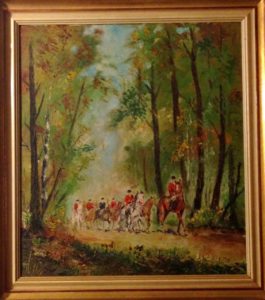 It struck us as a beautiful scene, one of foxhunters on horses, trotting on a trail through tall trees. The green and brown and red jackets of the hunters are vivid. We never thought of it before, but when looking at it lately, for some reason, this painting doesn’t show the dogs of the hunt. It’s our first buy, and we still enjoy it.
It struck us as a beautiful scene, one of foxhunters on horses, trotting on a trail through tall trees. The green and brown and red jackets of the hunters are vivid. We never thought of it before, but when looking at it lately, for some reason, this painting doesn’t show the dogs of the hunt. It’s our first buy, and we still enjoy it.
Though signed, we do not know anything about the person who painted it. It’s no great treasure, we suppose, but it has hung on a wall of every home since. It’s comforting.
Over the years, we collected other art work that we’ve liked, though none is greatly valuable. Among the best are at least two pieces of the work of the late George Keener, a local man-of-all-trades, who painted rural scenes of Georgia. They are scenes of contentment with nature.
Then there is another memorable painting that we bought, this one at auction, which has been with us at every home.
In the spring of 1962, we were living in Iowa when I was in graduate school, and we heard of a Grant Wood Festival in Anamosa, Iowa, the home of the painter of “American Gothic.” With our one-year old along, we attended the event. Besides focusing on Wood, other artists were showing their wares. The group promoting the event even had items you could bid on at a silent auction. Even though a poor student then, I put in a bid on one rural bridge painting of a few dollars….perhaps it was six dollars.
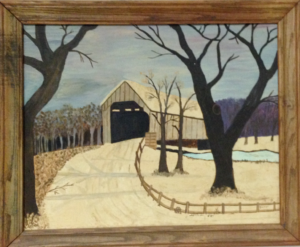 We left the festival before the winners of the auction were announced. About a week later, we got notice that we were the high bidder on the painting. We were instructed to send a payment, and they would ship us the painting. We were excited that we would get another item for our walls.
We left the festival before the winners of the auction were announced. About a week later, we got notice that we were the high bidder on the painting. We were instructed to send a payment, and they would ship us the painting. We were excited that we would get another item for our walls.
Each day we would check the mail, looking for the painting. We waited and waited. Finally, I wrote about the Festival. And eventually, the package arrived, and anxiously we unwrapped it to view our prize.
What we saw made us wonder. While it was a painting, it didn’t look as we remembered it. In fact, it was about the same scene, but appeared that it was a quickly-made copy of what we remembered bidding on. Not only that, but it didn’t seem to be of the same quality we remembered the painting we bid on. It wasn’t something that we felt proud of.
There seemed little we could do. It appeared we had a lousy copy of the painting we remembered. And it was of such low quality, we didn’t feel like hanging it on our walls for all to see.
We still have it. It’s hanging….in an upstairs closet, hidden away, you might say.
It’s not a prized possession.
Two memorable paintings on our walls: one we love, the other we hide.
- Have a comment? Send to: elliott@brack.net
Physical therapy program at PCOM gains accreditation
By Barbara Myers
SUWANEE, Ga. | The Commission on Accreditation in Physical Therapy Education (CAPTE) granted initial accreditation to Philadelphia College of Osteopathic Medicine’s Doctor of Physical Therapy program following its spring 2021 meeting. The accreditation, a voluntary, non-governmental, peer-reviewed process that occurs on a regular basis, is effective through the fall of 2025.
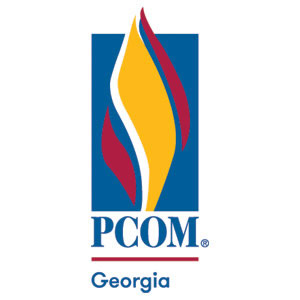 Under the leadership of Phillip B. Palmer, PT, PhD, professor and department chair, administrators and faculty members submitted a self-study report to CAPTE before the physical therapy program underwent a site visit at its Suwanee, Ga., location on the PCOM Georgia campus. The accrediting organization considered both the self-study and visit reports, along with an institutional response, prior to granting accreditation.
Under the leadership of Phillip B. Palmer, PT, PhD, professor and department chair, administrators and faculty members submitted a self-study report to CAPTE before the physical therapy program underwent a site visit at its Suwanee, Ga., location on the PCOM Georgia campus. The accrediting organization considered both the self-study and visit reports, along with an institutional response, prior to granting accreditation.
PCOM President Jay S. Feldstein, DO ’81, says: “It’s a credit to Dr. Palmer and his staff for achieving this significant goal for our PT program.”
CAPTE’s mission is to ensure and advance excellence in physical therapy education. In May of 2018, PCOM’s physical therapy program was granted Candidate for Accreditation status by CAPTE. In order to take the licensure exam, physical therapists must have graduated from a CAPTE-accredited program.
Dr. Palmer says: “Getting a new program accredited is only possible with the help of many people, both within and outside the program. Members of the PCOM community, on all campuses and in many non-academic departments, played a significant role in creating a positive environment for the program. The support and encouragement offered by the board and administration of PCOM cannot be overstated.”
According to the CAPTE website, CAPTE is the only accreditation agency recognized by the U.S. Department of Education and the Council for Higher Education Accreditation to accredit entry-level physical therapist programs. The organization currently accredits more than 250 physical therapist education programs in the U.S. and Scotland and conducts approximately 70 site visits annually.
Established in 2005, PCOM Georgia is a private, not-for-profit, accredited institute of higher education dedicated to the healthcare professions. The Suwanee, Ga., campus is affiliated with Philadelphia College of Osteopathic Medicine, a premier osteopathic medical school with a storied history. There are 1,215 students on the Suwanee campus. PCOM Georgia offers doctoral degrees in osteopathic medicine, pharmacy, and physical therapy and graduate degrees in biomedical sciences and physician assistant studies. Emphasizing “a whole person approach to care,” PCOM Georgia focuses on educational excellence, interprofessional education and service to the wider community. For more information, visit pcom.edu or call 678-225-7500.
- Have a comment? Send to: elliott@brack.net
Howard Brothers
 The public spiritedness of our underwriters allows us to bring GwinnettForum.com to you at no cost to readers. Today’s sponsor is Howard Brothers, which has retail stores in Alpharetta, Doraville, Duluth, Oakwood and Athens. John and Doug Howard are the “brothers” in Howard Brothers. This family-owned business was started by their dad, and continues to specialize in hardware, outdoor power equipment and parts and service. Howard Brothers are authorized dealers of STIHL, Exmark, Honda, Echo outdoor power equipment and Benjamin Moore paint. Howard Brothers is also an authorized Big Green Egg, Traeger Grill and YETI Cooler dealer.
The public spiritedness of our underwriters allows us to bring GwinnettForum.com to you at no cost to readers. Today’s sponsor is Howard Brothers, which has retail stores in Alpharetta, Doraville, Duluth, Oakwood and Athens. John and Doug Howard are the “brothers” in Howard Brothers. This family-owned business was started by their dad, and continues to specialize in hardware, outdoor power equipment and parts and service. Howard Brothers are authorized dealers of STIHL, Exmark, Honda, Echo outdoor power equipment and Benjamin Moore paint. Howard Brothers is also an authorized Big Green Egg, Traeger Grill and YETI Cooler dealer.
- Visit their web site www.howardbrothers.com.
- For a list of other sponsors of this forum, click here.
Send us your thoughts
We encourage you to send us your letters and thoughts on issues raised in GwinnettForum. Please limit comments to 300 words, and include your hometown. The views of letters are the opinion of the contributor. We reserve the right to edit for clarity and length. Send feedback and letters to: elliott@brack.net.
Perry is the new police chief in the City of Snellville
Snellville will get a new police chief as of July 1, as Chief Roy Whitehead retires after 17 years of service. Assistant Chief Greg Perry will be promoted as the new police chief.
Perry, a Brookwood High School and Reinhardt University graduate, started his career in law enforcement with the Stone Mountain Park Department of Public Safety. He joined the Snellville department in 2002. He previously served on the DUI Task Force, as a motor officer, on the Special Operations Unit, the Accident Investigation Unit, the Special Response Team and has served as assistant chief since 2016.
Perry has been named Gwinnett Chamber of Commerce Public Safety Officer of the Year, Gwinnett Chamber of Commerce Gold Medal of Valor winner, VFW Public Safety Officer of the Year, and National Street Level Interdiction Officer of the Year of the National Criminal Enforcement Association.
Whitehead, 69, graduated cum laude at the University of Georgia, attended Law School at Georgia State University and took Master’s courses at The Citadel. He has completed more than 4,000 hours of advanced training in law enforcement both in the military and as a civilian.
Whitehead helped design the current police department and increased department salaries to draw more qualified officers. He bolstered the Citizens Police Academy and CPA Alumni association which just completed its 30th class. He created programs such as Public Safety Night, Shop with a Cop, and Tip a Cop.
Under Whitehead’s leadership, SPD won the Governor’s Cup awarded in the Governor’s Challenge under the auspices of the Governor’s Office of Highway Safety the last two years.
County adopts new noise control ordinance as of June 1
The Gwinnett County Board of Commissioners has adopted a new noise control ordinance. The new ordinance, which goes into effect June 1, replaces the county’s noise control ordinance that was adopted in 2015.
 The new ordinance uses the plainly audible standard for determining whether a sound is a violation of the ordinance. Under the new ordinance, sound will be regulated based upon the location, time of day and distance from which the sound is plainly audible.
The new ordinance uses the plainly audible standard for determining whether a sound is a violation of the ordinance. Under the new ordinance, sound will be regulated based upon the location, time of day and distance from which the sound is plainly audible.
Under the ordinance, sound from consumer fireworks is regulated generally with other sounds on days and times not preempted by state law.
Additionally, a permit process was created to accommodate events that might briefly exceed the sound limit. Information about permits and applications for permits may be obtained from the Gwinnett County Department of Planning and Development.
Braselton adopts new methods to report problems
The Town of Braselton is making it easy for residents to report concerns via text. Potholes, litter, broken street signs and similar issues can be speedily addressed by the town with the help of this new program.
 Town Manager Jennifer Scott says: “One of the great things about living in a small town is the direct communication that residents can have with their local government. It’s a priority of town staff to be accessible to the public and to respond quickly to residents’ concerns. This new texting program helps us do that.”
Town Manager Jennifer Scott says: “One of the great things about living in a small town is the direct communication that residents can have with their local government. It’s a priority of town staff to be accessible to the public and to respond quickly to residents’ concerns. This new texting program helps us do that.”
Residents can report a “problem, place and picture” via text to 706-654-5720. A staff member will investigate the issue and respond back to the sender to let them know the resolution.
The program should never be used to report illegal activity or emergencies. For those situations, directly contact the Braselton Police Department by calling 9-1-1.
The Children’s Book by A. S. Byatt
![]() From Karen Harris, Stone Mountain: This is a wondrous excursion through the lives and times of several families and the magic that is made in 19th century England, Germany, and France prior to the start of World War I. The matriarch of the clan is an accomplished writer of children’s stories. She lives with her family on a vast estate that includes seven children, each of whom has a book written specifically about them in the form of a magical tale peopled with other worldly characters. In the backdrop of the story are the relationships that are forged between family members and burgeoning conflict that leads to WWI and the end of the Edwardian Age. The Children’s Book can be called a “steep read” because of the multi-layered nature of the book. It is a long and riotous read into a period of history, the complexity of relationships and the double edge sword of creativity.
From Karen Harris, Stone Mountain: This is a wondrous excursion through the lives and times of several families and the magic that is made in 19th century England, Germany, and France prior to the start of World War I. The matriarch of the clan is an accomplished writer of children’s stories. She lives with her family on a vast estate that includes seven children, each of whom has a book written specifically about them in the form of a magical tale peopled with other worldly characters. In the backdrop of the story are the relationships that are forged between family members and burgeoning conflict that leads to WWI and the end of the Edwardian Age. The Children’s Book can be called a “steep read” because of the multi-layered nature of the book. It is a long and riotous read into a period of history, the complexity of relationships and the double edge sword of creativity.
An invitation: what books, restaurants, movies or web sites have you enjoyed recently? Send us your recent selection, along with a short paragraph (150 words) as to why you liked this, plus what you plan to visit or read next. Send to: elliott@brack.net
Re-founded Oglethorpe University opened doors in 1916
In 1912 a Presbyterian minister named Thornwell Jacobs began campaigns in Atlanta and the South to re-found Oglethorpe University. (The original founding was in 1835.) His grandfather, Ferdinand Jacobs, had served on the faculty of old Oglethorpe. In 1913 the institution was incorporated by the state of Georgia.
Linking the old with the new, members of the classes of 1860 and 1861 witnessed the laying of the cornerstone of the present campus in DeKalb County. The re-founded Oglethorpe University opened its doors in 1916. Although Presbyterians contributed generously to the revival of the institution, it never reestablished a denominational affiliation and has been independent, nonsectarian, and coeducational since the 1920s.
Jacobs intended the university to be a “living memorial” to James Oglethorpe. The institution holds the finest portrait of Oglethorpe and the only painting of his wife, Elizabeth. The collegiate coat of arms, emblazoned with three boars’ heads and the inscription Nescit cedere (“He does not know how to give up”), replicates the Oglethorpe family standard. For the college athletic teams, Jacobs chose an unusual mascot, the petrel (pronounced “pea-trel”)—a small, persistent seabird that, according to legend, inspired Oglethorpe while on board the ship Anne on the way to Georgia.
The university’s Gothic revival architecture was inspired by James Oglethorpe’s honorary alma mater, Corpus Christi College at Oxford University in England.
The historic halls, constructed from 1915 to 1929, are made of blue granite from Elberton, trimmed with Indiana limestone, and topped with variegated gray-green slate roofs. Thomas Henry Morgan, the “dean of Atlanta architects,” led the design. The Oglethorpe campus is actually an unfinished work. The original design was to be twenty-six buildings arranged in the form of a Greek cross. Tower forms, gabled roofs, double-hung leaded windows, and battlements are displayed in three halls. They honor the families of Oglethorpe’s prominent benefactors: publisher William Randolph Hearst, Atlanta banker Colonel Robert Lowry, and Coca-Cola bottling franchise owner John T. Lupton of Chattanooga, Tenn.
The most striking feature of the Oglethorpe campus is the Lupton bell and clock tower, built in 1920. This four-story structure fronting Peachtree Road has a three-face clock set in a massive, square, flat-topped tower with battlements, projecting the appearance of a fortified castle. In 1972 the university added a 42-bell cast-bronze carillon, one of the finest in Georgia, to complement the original ten bells.
Another landmark on the campus is Hermance Stadium. Named after benefactor Harry Hermance, it was intended to be bowl-shaped. Hermance dedicated the first section on October 26, 1929, and lost his entire fortune three days later in the stock market crash. The structure, which is only one-eighth of the proposed project, stands as a monument to the Great Depression.
Under President Thornwell Jacobs (1916-43) Oglethorpe University fostered many innovations. These included perhaps the first summer school in Georgia (1919); some of the earliest celebrity-laden commencement ceremonies (Franklin D. Roosevelt and Martha Berry have been among the more than 150 notables to receive honorary degrees); one of the earliest collegiate presses in the South and an extensive teacher training program, both established in the 1920s; the “University of the Air” experiment, which broadcast college courses by radio in the 1930s; and the Crypt of Civilization, a multi millennial time capsule sealed in 1940
- To view the Georgia Encyclopedia article online, go to http://georgiaencyclopedia.org
Natural light streams in from above in this Mystery Photo
Think of the natural light that can enter this space through this soaring multi-glassed ceiling! It must be gorgeous with all the plants inside this architecturally-distinctive space. But where is this Mystery Photo? Send your answer to elliott@brack.net to include your hometown
The previous Mystery Photo was quickly recognized by George Graf of Palmyra, Va.: “It is the original Hotel DeSoto in Savannah, a 300-room resort, designed by William G. Preston and built in 1890. It closed in 1965 and was demolished.” The photo of the DeSoto came from David Earl Tyre of Jesup, Ga.
Allan Peel of San Antonio, Tex. gave a little more background: “Today’s mystery photo is from a 1909 postcard of the original Hotel DeSoto in Savannah which was built by William Gibbons Preston (1842 – 1910). First opened to the public on New Year’s Day 1890, this 300-room, high-end resort catered to celebrities, dignitaries, authors, and U.S. presidents William McKinley, William Howard Taft, Woodrow Wilson, and Herbert Hoover.
“The 1890 DeSoto was ultimately demolished in 1965 to make way for a larger, grander, and more modern (if not more boring from an architectural perspective) DeSoto Hilton (now called the DeSoto Savannah) that sits on the site today. The current DeSoto does pay homage to its predecessor by displaying remnants of the Terra Cotta artwork from the original hotel throughout the new building, and uses the original 1890 crystal chandelier to light up its lobby.”
Others recognizing the mystery included Lou Camerio, Lilburn and Susan McBrayer, Sugar Hill.
New Duluth library is most advanced library in USA today
Modern public libraries are no longer mere depositories for people to check out books these days. We’ll suggest that this new $5.1 million, 22,038 square foot library (more than double its previous size) is one of the most advanced in the nation. Within these walls, besides the 36 computer stations, you can find meeting space for 120 people, use a futuristic 3-D printer, make your own clothes with ultra-modern sewing machines, record video with multiple backgrounds via a green screen…and yes, settle down and study or read, or even easily check out a book. Here are several views of the library by Victoria Hopkins.
Stacks and stacks of books await you, along with comfortable, colorful seating, with light pouring through tall windows.
Take your seat at the computer stations and start writing letters, checking the Internet, or doing your homework.
The library is equipped with the most up-to-date 3-D printing systems available.
Make your own clothes, or simply darn a torn spot, with these sewing machines.
The camera and lights are awaiting your next recording. Find a friend and interview them. Who knows? You could be a YouTube moviemaker.
- Have a comment? Send to: elliott@brack.net
GwinnettForum is provided to you at no charge every Tuesday and Friday.
Meet our team
- Editor and publisher: Elliott Brack, 770-840-1003
- Managing editor: Betsy Brack
- Roving photographer: Frank Sharp
- Contributing columnist: Jack Bernard
- Contributing columnist: Debra Houston
- Contributing columnist: George Wilson
More
- Location: We are located in Suite 225, 40 Technology Park, Peachtree Corners, Ga. 30092.
- Work with us: If you would like to serve as an underwriter, click here to learn more.
Subscriptions to GwinnettForum are free.
- Click to subscribe.
- Unsubscribe. We hope you’ll keep receiving the great news and information from GwinnettForum, but if you need to unsubscribe, go to this page and unsubscribe in the appropriate box.
© 2021, Gwinnett Forum.com. Gwinnett Forum is an online community commentary for exploring pragmatic and sensible social, political and economic approaches to improve life in Gwinnett County, Ga. USA.





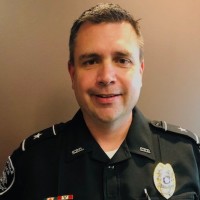
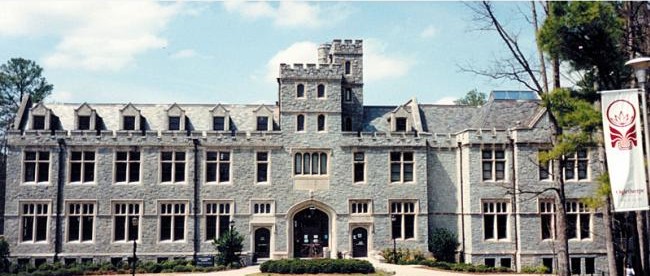
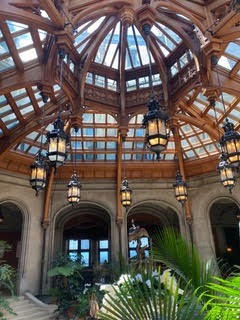
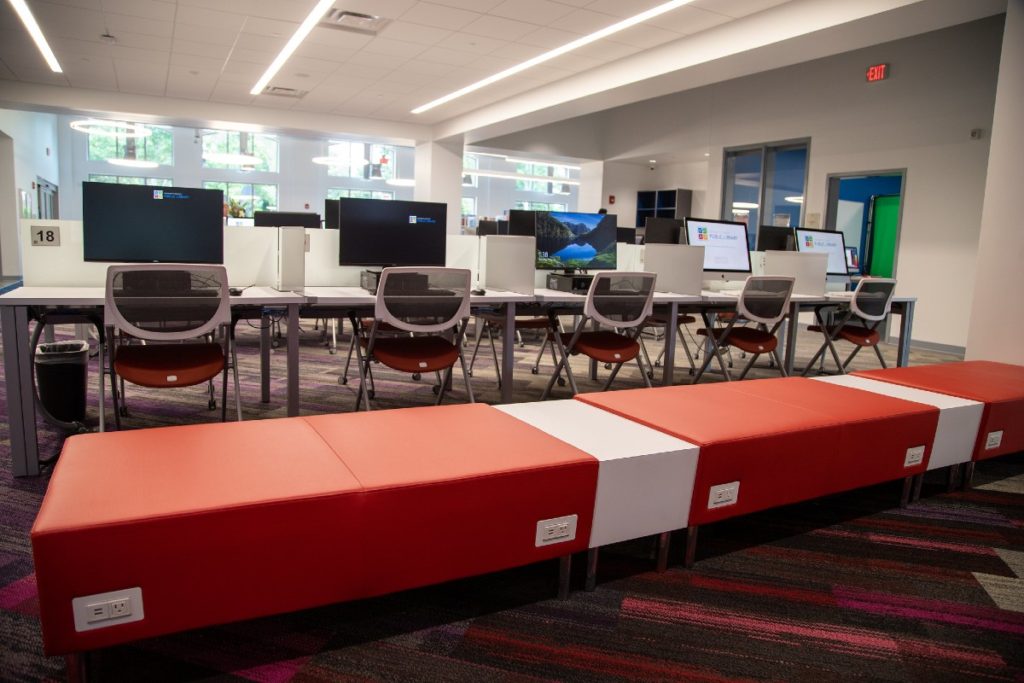

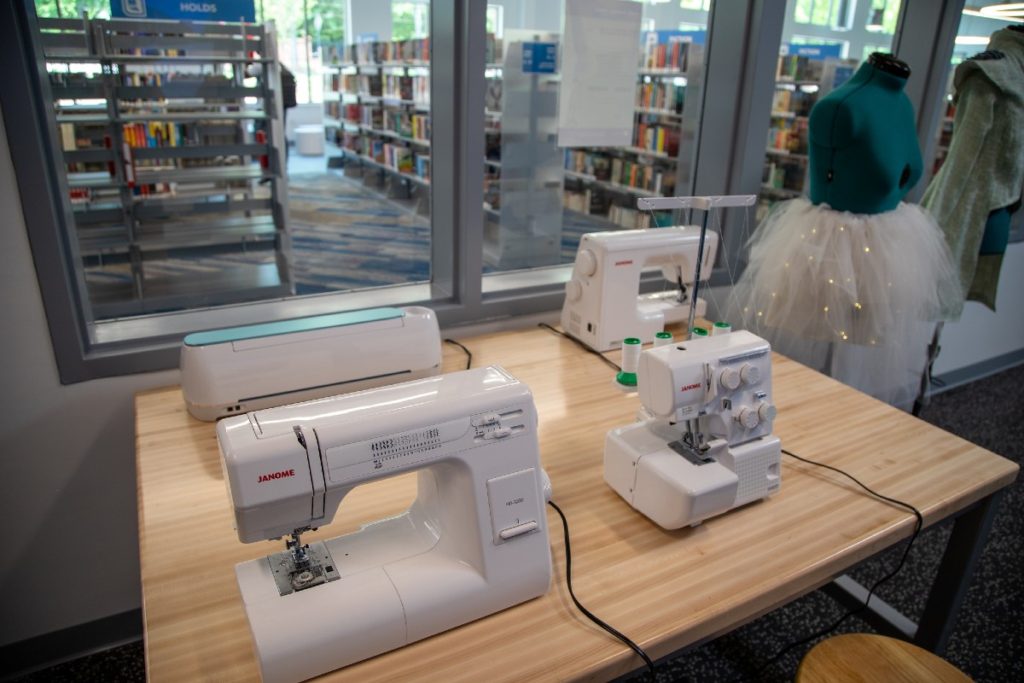








Follow Us